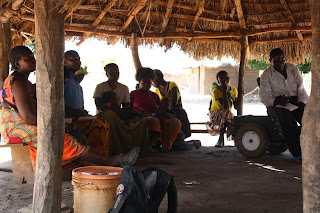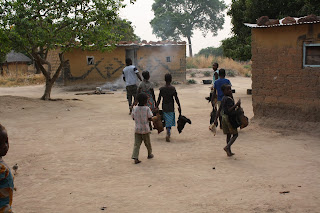I'm a big fan of planting trees. Out of one small seeds comes something large and worthwhile: a tree. And that tree can provide services for people like shade, food, and nitrogen-fixation among other for years and years, even decades. Yet, poverty and intensive use of forest resources are causing deforestation on a wide-scale here in Zambia. And, unfortunately, trees aren't being put back in place of those cut. There is a lot of deforestation, but minimal reforestation. It's a serious problem with long-term impacts.
In my community we're trying to alleviate some of these issues by planting our own trees. With some help from the village's kids, we've been busy planting trees, trees, and more trees. I plant all kinds of trees: some that live a long time (red mahogany and other local species), some that can be used for food (mangoes, guavas, moringas), some that improve soil fertility (msangu, tephrosia, and pigeon pea), and some that just look nice (jacaranda and flamboyant). Trees serve a variety of purposes, so I've aimed to plant a wide-array of them.
 |
| Anything can be used in a tree nursery to hold seedlings, even Pop-Tarts boxes from the United States. Although black plastic bags, provided by the Forestry Department, work the best. |
I think that part of the issue with replanting projects is that it takes a lot of planning ahead and looking to the future in order to be successful, and neither of things can be simply taught. Instead, they take years of education and behavior change to really develop. So, we're chipping away at old notions that the forests are infinite and looking at them as valuable, truly invaluable, and finite resources worth careful management.
It hasn't been easy though and I've had to try a lot of different techniques. Some worked a little bit, some failed badly, and none have been overwhelming successes - except one. That would be working with kids. Kids love to help me with projects and there is no other project that I want more help with than planting trees.
To me, planting trees is also a kind of legacy project at some level. I know that if I help a farmer plant trees that benefit their lives then they'll be able to look at the tree and remember that I was there, but more importantly what I taught: trees are just as necessary as clean water and air - without them we would have a far less worthwhile life. It sounds narcissistic, I admit this, but I do think that as a volunteer I have to think along these lines to a certain extent by using what influence I have to create an interest and desire to use what is taught / what is learned to benefit the future.
Planting a tree isn't planting for tomorrow or even the week after... it's planting for the long-term future and the long-term well-being of a community. It isn't an easy concept to pass on, but it is absolutely important.
My boss at Peace Corps loves to say, "The best time to plant a tree was ten years ago, the second best time is today." I take that to heart and will keep on planting for the future.










































